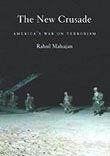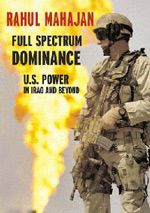I’ve recently had the dubious pleasure of
reading the 9/11 commission’s 500-page report, available in book form
and
on
the Web.
The report points out that, far from some generalized “war on
terrorism,” what we are faced with is a war on al-Qaeda and groups of
similar ideology and tactics. In particular, in their view, the United
States has a very clear and well-defined enemy, if one that is harder
to track down and isolate than the armies of nation-states.
And, says the commission, the enemy is composed of evildoers. In the
introduction, the commissioners say, “We learned about an enemy who is
sophisticated, patient, disciplined, and lethal. The enemy rallies
broad support in the Arab and Muslim world by demanding redress of
political grievances, but its hostility toward us and our values is
limitless.” One sentence later, they add, “It makes no distinction
between military and civilian targets. Collateral damage is not in its
lexicon.”
You’ve all heard this kind of reasoning – on the left, from Richard
Falk, who opposes some U.S. wars but supported the one in Afghanistan
as a war against “apocalyptic terrorism." Basically, if for no other
reason, this
war is right because the other side has such great “hatred for innocent
life,” as George Bush would put it.
And I don’t want to minimize the threat from jihadi terrorists, from
Bali to Madrid. But I’ll tell you what I think of when I hear about
complete lack of respect for human life.
I must have been about nine or ten when I read my first book about the
Manhattan Project, and I learned that, when they dropped the bomb on
Hiroshima, the altitude at which it was set to explode was calculated
to maximize the damage. You see, if the bomb explodes too close to the
ground, then some of the blast is shielded by the ground and the range
of destruction is less. And if it explodes too high up, then the force
is attenuated by the time it hits the target. So they carefully
calculated the exact right height at which it should explode in order
to maximize the killing.
Just as in the statement of the 9/11 commission, no distinction was
made between military and civilian targets. Harry Truman even had the
gall to say, “The world will note that the first atomic bomb was
dropped on Hiroshima, a military base.” Actually the entire reason that
Hiroshima was selected was that it had so little military value that it
had suffered virtually no bombing to that point and would give a good
standard for judging the bomb’s destructive capacity.
People who are not Americans do not need detailed explanations of why
the Hiroshima bombing was a deeply immoral act. For the rest of you,
there is Gar Alperovitz’s magisterial work, “
The
Decision to Drop the
Atomic Bomb,” which documents how the United States knew that Japan
would have surrendered without the bomb or an invasion, as well as the
creation of the standard myth about how the bombing saved lives.
Three days later, fifty-nine years ago today, a second bomb was dropped
on Nagasaki, perhaps the single most gratuitous act of mass slaughter
and mass terrorism in human history.
Hiroshima and Nagasaki continue to shed light on issues that face us
today, but unfortunately we have failed to learn the lessons they
should have taught us. The Bush administration is currently attempting
to start a new nuclear arms race. The racism that is at the heart of
the attempt to revive colonialism in Iraq, and of its failure, was
centrally entwined in the Greatest Generation’s Good War as well. A
poll conducted in December 1944 had 13% of Americans saying that all
Japanese should be exterminated after the war was over. Most of all we
still, most of us, refuse to understand that apocalyptic terrorism can
be and is carried out by human beings who look much like us.
As Alperovitz says at the end of the introduction to his book,
“Hiroshima and Nagasaki – now – I think, have very little to do with
the past. How we choose to deal, with them, I believe, may have
everything to do with the future.”

 Home ArticlesLettersArchives
Home ArticlesLettersArchives  "Report
from Baghdad -- Hospital Closings and U.S. War Crimes "Report
from Baghdad -- Winning Hearts and Minds"Report
from Fallujah -- Destroying a Town in Order to "Save" it"Report
from Baghdad -- Opening the Gates of Hell"War
on Terrorism" Makes Us All Less Safe Bush
-- Is the Tide Turning?Perle and
FrumIntelligence
Failure Kerry
vs. Dean SOU
2004: Myth and
Reality
"Report
from Baghdad -- Hospital Closings and U.S. War Crimes "Report
from Baghdad -- Winning Hearts and Minds"Report
from Fallujah -- Destroying a Town in Order to "Save" it"Report
from Baghdad -- Opening the Gates of Hell"War
on Terrorism" Makes Us All Less Safe Bush
-- Is the Tide Turning?Perle and
FrumIntelligence
Failure Kerry
vs. Dean SOU
2004: Myth and
Reality